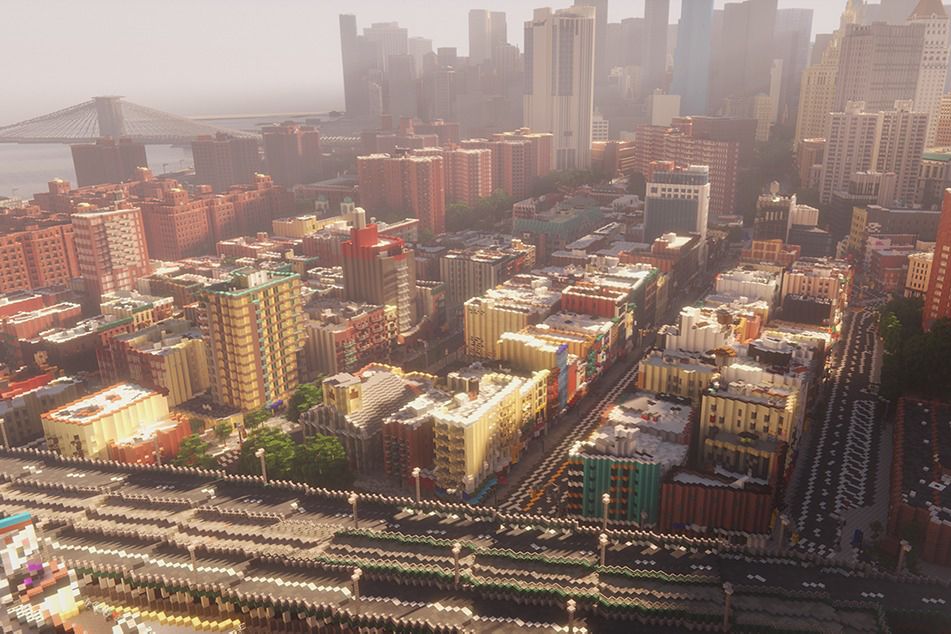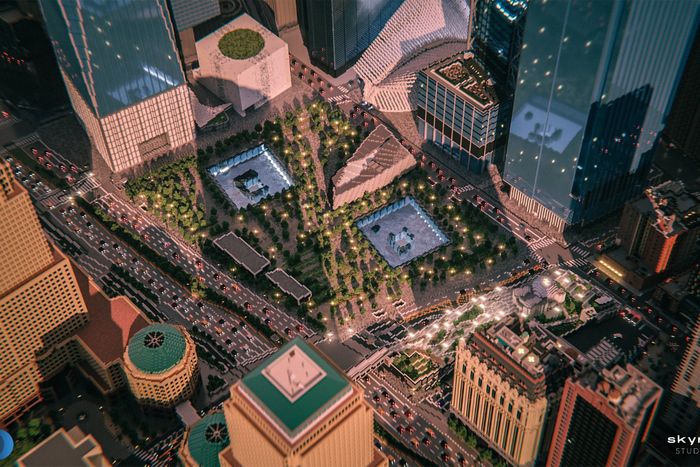
It’s not surprising that video games — a reliable vehicle for escapism and stress relief — experienced a pandemic popularity boom. This was especially true for Minecraft, the best-selling game of all time, which saw 141 million active monthly users during 2021. With an array of simple, three-dimensional blocks at their disposal, players can fashion almost anything. They have re-created all of Westeros from Game of Thrones, an imagined version of the ancient city of Babylon, and complex structures like France’s Orleans Cathedral. It wasn’t until the upheaval of the past two years and a simultaneous coding breakthrough that the dream of constructing the entire Earth finally felt achievable, or at least worth attempting.
In this project, called Build the Earth, the largest team has 2,731 members around the world, who are dedicated to a single goal: Reconstructing New York City on a 1:1 scale, with each Minecraft building block representing one cubic meter of the real world.
The leader of the New York City team is a 21-year-old coder from Frankfurt, who goes by the username Minefact. He originally wanted to build his neighborhood in Frankfurt using a generator he developed in late 2019, which creates rough outlines of buildings inside the game using Google Maps data. On a whim, he tested the program on New York City, and entire neighborhoods rose in gray scale across his screen. “The quality was so much better than in Frankfurt because the open-street map data is so good in New York City,” he said. Drawn by the prospect of rebuilding an architectural mecca, he decided to put off building his hometown in Germany and switch to the city. Just as he was about to begin, Build the Earth launched, and he merged his project with the larger one.
Build the Earth began in March 2020, when a user, PippenFTS, uploaded a video to YouTube explaining two modifications he had made to Minecraft that had created a rough, completely terraformed outline of the Earth’s geological surface. He suggested filling it with the world’s buildings. It was an absurd proposition, but, soon after, tens of thousands of people signed up. “Literally a week into the quarantine and we’ve already replaced the outside world,” wrote a commenter.
“Everyone was trapped inside their house, and so people started to meet in-game, in this new real life, where they could create the world they had known outside,” said Minefact in his fluent, German-accented English. “So it’s a bit like the metaverse, just in a different, low-key style.”
Where to lay the first brick? Minefact picked the 9/11 memorial. The neat geometry of the site — two identical pools, surrounded by a thicket of trees, adjacent to a blocky, triangular museum, built on a flat parcel of land — was ideal for block construction. But something strange was happening on his map: The pool’s squares were distorted, stretched into rhombuses. Other players, in other parts of the world, reported similar incongruities. “We realized the current projection didn’t work,” he said. “So we had to create a new one.”
With tens of thousands of builders ready to go, Build the Earth’s organizers put the project on pause. They had been working off of a map based on the Mercator projection — the map on every classroom wall, ubiquitous since 1569, that warps shapes towards the poles. (Russia is about half as big as it appears on Google Maps, which also uses this projection.) To avoid filling the world with misshapen, funhouse-mirror buildings, they consulted Daniel Strebe, a mathematician specializing in map projections. Over one frenzied week, they developed a novel projection, which they called Airocean, that focused distortion in the oceans rather than land. Strebe first found the project amusing (“Thank you for your interesting inquiry,” he wrote), but this eventually morphed into something like awe (“It looks like you are barreling right along. I didn’t realize this was very much in progress”). Construction resumed shortly after. “The servers could barely keep up,” said Minefact. “It was a great time.”
The 9/11 memorial build session, captured in a time-lapse video, is hypnotic to watch. Players swarm through the air, their shadows streaking across the ground, clearing away the computer-generated outline. A concrete foundation is laid. Two holes appear in the earth, become deeper, and fill with dark water. Off to the side, a kind of scaffolding is erected — height markers for the Oculus train station, designed by the architect Santiago Calatrava, the wings of the structure fanning out, cube by cube, to their fullest expanse. These sessions, which take place several times a week, for several hours each, are responsible for most of downtown’s progress.
Two years into the project, they construct the city in short and mobile sprints. “We circle around different districts,” explained Minefact. “We work one week in Chinatown, then one week in Tribeca, one week on Bowery and then come back to Chinatown. We always work on multiple districts at the same time to keep things interesting.”
With an entire city to reconstruct, players gave themselves a reasonable limit: They would only craft the exteriors of buildings. But certain public spaces, like Grand Central Terminal, proved irresistible. “We made an exception because there is a lot of data for it,” said Minefact. “And people actually went to the station and took photos of it from each corner to create the inside.” Anxiety was their primary motivation, he said. They were afraid the web-derived images they were using as references were off-color. This maniacal obsession with precision is the project’s animating force. It’s why builders compulsively circle back to completed areas, despite how much of the map is still a patchwork of gray shells. One player is reconstructing all of the buildings in the Financial District, which was technically finished last year.
“He’s going from the very bottom, just working his way up, rebuilding all the old buildings, making them better than I ever could do,” said Tyler, a university student from Darby, England, who goes by D3cent.
New York County Supreme Court as built in Minecraft blocks.
The Minecraft interior of Grand Central.
The Minecraft St. Patrick’s Cathedral.
An aerial view of Minecraft Soho.
New York County Supreme Court as built in Minecraft blocks.
The Minecraft interior of Grand Central.
The Minecraft St. Patrick’s Cathedral.
An aerial view of Minecraft Soho.
“You go back and look at the builds we did a year ago, or even longer than that, and compare them to what we’re doing today,” said Robert, an admin from Toronto who goes by the username Bobert. “You can see that there’s a real difference in terms of accuracy, in terms of how good it all looks.”
None of these players — Minefact, D3cent, Bobert — has ever been to New York City. But they all hope to visit, ideally before the project is complete. At the current pace, Manhattan could be finished in a matter of years. The entire city, which contains around one million buildings, would take decades.
“One day, I’ll go,” said Minefact. “And I’ll probably be perfectly oriented, since I kinda created the whole city.”
from WordPress https://ift.tt/7XpxWot
via IFTTT








No comments:
Post a Comment